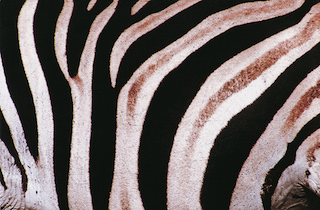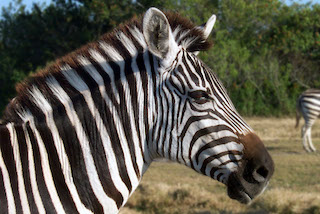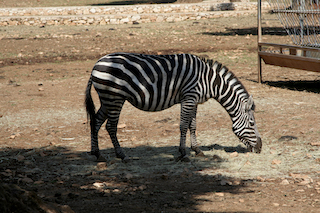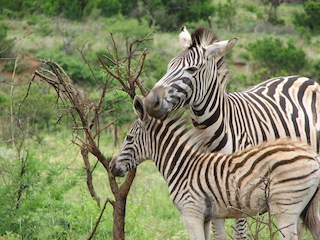2 Theories About The Black And White Stripes Of Zebras
Genetics

2 Theories About The Black And White
Genetics determine the striping patterns of zebras. It has to do with selective pigmentation caused by melanocyte skin cells during the embryonic phase. In the uterus, the dark pigment melanin deactivates its function in certain areas of skin thus forming the black and white stripes.
Theories
Various theories have been put forward as to the function of zebra stripes. According to a school of thought, its equine ancestor was striped, but they lost it during the evolution of horses and asses. Zebra’s black and white stripes remain a mystery to science even today because they seem very out of place in the bush, in particular against a plain savanna background. Zoologists have yet to unravel the mysteries behind its signature striped suit. Scientists are not sure why zebras have not blended in with the browns and reds or why they have stripes. There are many theories and counter-theories to this riddle. Let us examine 2 such theories.
1) Camouflage

2 Theories About The Black And White
The most long-standing hypothesis was debated by Alfred Russell Wallace and Charles Darwin. It goes as follows. Although the stripes of zebras blend well into natural light, too many bars confuse predators and form an optical illusion because the streaks of a herd merge into a big mass. In other words, zebras running together as a pack appears like a giant striped blob. So, predators get confused and misjudge distances. That makes it tough for predators to remain focused on a single zebra. Hence stripes in a herd of zebras have a camouflaging effect so as to keep predators away.
2) Identification
 Another longstanding theory was that zebras identify each other in a herd because of the uniqueness of stripes. Their stripes differ so significantly that members can recognize their own. It is as unique as fingerprints in humans. And in fact, researchers in the field have used these individual stripes for identification.
Another longstanding theory was that zebras identify each other in a herd because of the uniqueness of stripes. Their stripes differ so significantly that members can recognize their own. It is as unique as fingerprints in humans. And in fact, researchers in the field have used these individual stripes for identification.
Theories refuted
An in-depth study has refuted both the camouflage and the identification theories. In a project supported by National geographic society, a group of biologists from the University of Calgary and the University of California Davis visited 16 zebra populations in Africa to test these ideas and to determine the veracity. They discredited the camouflage hypothesis and rejected this long-held theory because the researches done by them provided no evidence that the stripes provide any camouflaging effect. In fact, they discovered that predators cannot distinguish zebra stripes beyond 30 meters at twilight or 50 meters in daylight. Moreover, they found that the predators could see the outline of zebras just as quickly as other animals. Also, the study did not yield enough support even for the other socializing advantage theory that zebra stripes stimulate group cohesion and grooming behavior. The researchers noted that other animals that are closely related to zebras are also highly sociable and are able to recognize their own despite having no stripes to distinguish them.
Alternatives
The researchers and scientists not only refuted the earlier schools of thought as to why zebras have stripes but also attempt to list 2 likely possibilities. The stripes have a cooling effect, and it helps to fend off parasites that are common in hotter climates. According to the journal Royal society open science, no one theory teases out as the definite winner.
Cooling theory
Scientists found a correlation between temperature and line patterns. The study proves that zebras in warmer climates have more stripes to keep them cool, fresh and healthy. When air currents hit a zebra, it is slower over the white parts and stronger over the black parts causing opposing airflows. These little eddies of air serve to calm the zebra’s skin. In other words, stripes keep zebras cool in warmer climates. There is evidence to suggest that heavily striped zebras have lower surface temperatures than non-striped animals in the same area. The alternating color pattern deflects up to 70% of the heat.
Parasite-fender theory
New research shows that the stripes on zebras stave off disease-spreading insects and dissuade blood-sucking horseflies that recognize only single-colored fur. They are least attractive to a zebra’s hides. They don’t like to land on striped surfaces. Thus, stripes act as an insect repellant. Scientists from Sweden and Hungary published this in the Journal of experimental biology. The team points out that zebra embryos start out with dark skin and go on to develop white stripes before their birth. The zebra’s stripy hide evolved to disrupt their beautiful coats making them less appealing to voracious bloodsuckers. Hence the striped coat pattern was a response to blood-sucking parasites. Ongoing future studies and field research may be able to solve the stripe-riddle of zebras. Or a whole new theory may emerge.
To receive a colourful digibook about Zebra with videos, images and text, please fill out the following form or simply email us on safaris@safari-center.com





